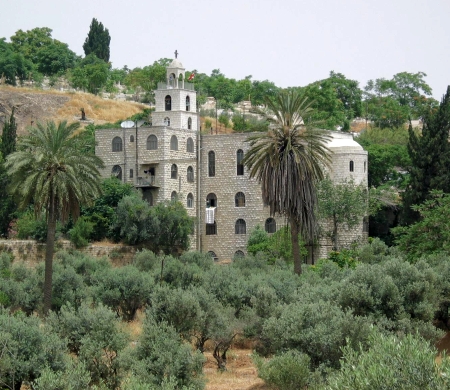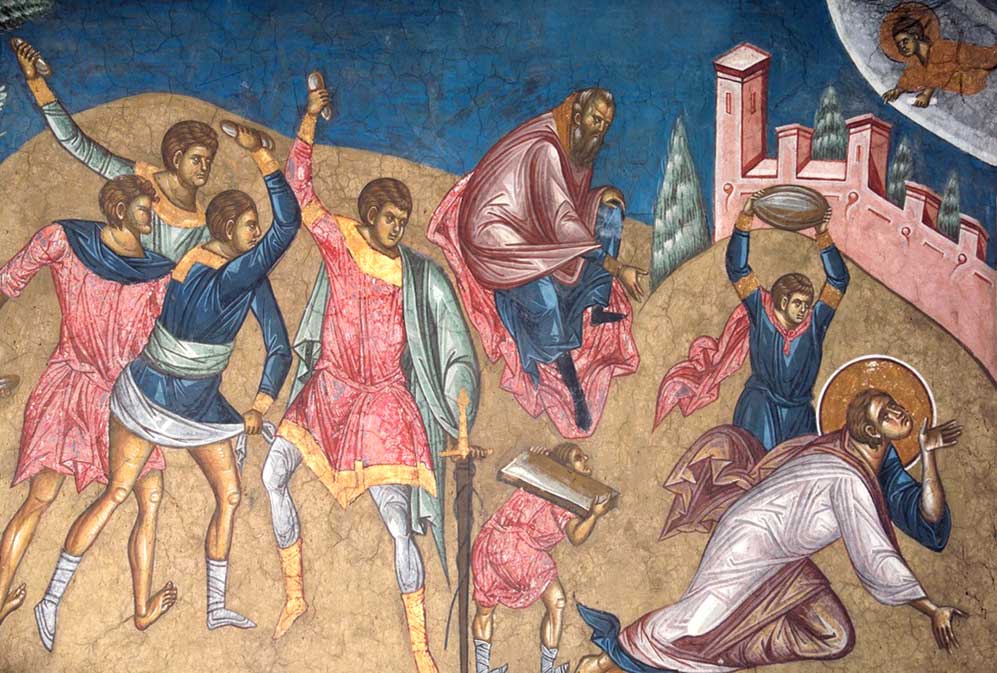 St. Stephen Church in Jerusalem is a Greek Orthodox Church immediately outside the ancient city walls, between Lions Gate and Temple Mount. Coming out of Jerusalem through “Lions Gate” and descending in Cedar Valley, immediately on the right, is the church dedicated to St. Stephen the Archdeacon and First Martyr.
St. Stephen Church in Jerusalem is a Greek Orthodox Church immediately outside the ancient city walls, between Lions Gate and Temple Mount. Coming out of Jerusalem through “Lions Gate” and descending in Cedar Valley, immediately on the right, is the church dedicated to St. Stephen the Archdeacon and First Martyr.
According to local tradition, this church was built on the place where Saint Stephen gave glory to God by martyr’s death. Because through this gate to the holy city was out of the city, it is called “Gate of St. Stephen”.
It is believed that the first Christian church in this place was founded by Empress Evdokia, sometime in the late fifth century to house the relics of the venerable Christian protomartyr. The monastic community that was born around this church was so great that, in the early sixth century, it gathers nearly ten thousand monks.
 In the twelfth century, the church built by Empress Evdokia was demolished by the Crusaders in their plan to not offer Salah id-Din no retreat, outside the walls of Jerusalem. New church dedicated to St. Stephen was built in 1900, largely on the ruins of the old. In 1890, this place would be founded a renowned “Bible School”.
In the twelfth century, the church built by Empress Evdokia was demolished by the Crusaders in their plan to not offer Salah id-Din no retreat, outside the walls of Jerusalem. New church dedicated to St. Stephen was built in 1900, largely on the ruins of the old. In 1890, this place would be founded a renowned “Bible School”.
Choosing deeds and martyrdom of St. Stephen are reported in detail by St. Luke, in the book “Acts” in Chapters 6 and 7. Thus, we learn that Stephen was a Christian Greek nation, especially the apostles in Jerusalem and ordained to take care of her Greek-speaking poor in the city.
At that time the disciples were multiplied, they began to appear some disagreements between them, mostly on meals in common and also other ministries. In order not to leave aside the Gospel preaching, to take care of ordinations less important matters, the Jerusalem apostles chose seven men devout, who then did ordain deacons (Stephen, Philip, Prochorus, Nicanor, Timon, Parmenas and Nicholas).
 Saint Stephen was well aware of Scripture and Christ preached with much power. The Sadducees and Pharisees put some men to say that they heard him speak blasphemous words against Moses and God. At that time, blasphemy was punishable by death.
Saint Stephen was well aware of Scripture and Christ preached with much power. The Sadducees and Pharisees put some men to say that they heard him speak blasphemous words against Moses and God. At that time, blasphemy was punishable by death.
“Stephen, full of grace and power, did great wonders and signs among the people. And they raised some of the synagogue that was called a liberal and a Cyrenens and Alexandrians and of those from Cilicia and Asia, remonstrate themselves with Stefan. And they could not withstand the wisdom and the Spirit with which he spoke. Then they put some men to say: “I heard saying blasphemous words against Moses and God.” They stirred up the people and elders and the scribes and fell upon him, kidnapped him and took him to the council. And they put false witnesses, saying, This man does not cease to speak blasphemous words against this holy place and the law. As I have heard him say that this Jesus of Nazareth will ruin this place and change the customs that we allowed the new Moses. And fixing his eyes on him, all who sat in the council saw his face like the face of an angel . ” (Acts 6, 8-15).
 After an ample speech of the saint, the Jews became harder against him, deciding the stoned “And they heard these things, quivering with rage in their hearts and gnashed their teeth at him. And Stephen, filled with the Spirit Spirit and looking up to heaven, saw the glory of God and Jesus standing at the right hand of God. He said, “Behold, I see the heavens opened and the Son of Man sitting at the right hand of God!” And they cried with a loud voice, and stopped their ears and rushed on him. And taking him out of the city, beat him with stones. And the witnesses laid down their garments at the feet of a young man named Saul. And beat him with stones Stefan, who prayed, “Lord Jesus, receive my spirit!” And he kneeled down, and cried with a loud voice, “Lord, lay not this sin to their count!” he had said this, he died. ” (Acts 7, 54-60).
After an ample speech of the saint, the Jews became harder against him, deciding the stoned “And they heard these things, quivering with rage in their hearts and gnashed their teeth at him. And Stephen, filled with the Spirit Spirit and looking up to heaven, saw the glory of God and Jesus standing at the right hand of God. He said, “Behold, I see the heavens opened and the Son of Man sitting at the right hand of God!” And they cried with a loud voice, and stopped their ears and rushed on him. And taking him out of the city, beat him with stones. And the witnesses laid down their garments at the feet of a young man named Saul. And beat him with stones Stefan, who prayed, “Lord Jesus, receive my spirit!” And he kneeled down, and cried with a loud voice, “Lord, lay not this sin to their count!” he had said this, he died. ” (Acts 7, 54-60).
Because it is customary that those stoned not to be buried in the family tomb, it is believed that St. Stefan was placed outside Jerusalem. The venerable relics of the saint were taken for burial by Gamaliel in Gamala Caphar village, somewhere in northern Jerusalem.
After hundreds of years, Gamaliel he appeared three times in a dream by Lucian, priest of Cafargamala. Moved by his dream, Lucian went to the patriarch and taking blessing came with a large group of priests and holy body unearthed. Honoured relics were discovered in the year 415, when Empress Evdokia built a church in his honor.
After finding them, they were moved to the procession in Sion and buried in a church built by the nobleman Alexander. It is said that when this gentleman died, was also made a cypress coffin at the holy grave and was buried near St. Stephen. Juliana, wife squire Alexander, wanting to take her husband’s body and take him to his country, to Constantinople, ranging from divine providence, left her husband’s coffin, and shedding many tears, took the holy shrine. His relics 560 Since they are with the bones of the Roman Archdeacon Laurentius (258) in the crypt of the church “San Lorenzo fuori le Mura” in Rome.
Finding his venerable relics in 415 year is celebrated in September 15, and move them in Constantinople is celebrated on 2nd of August. On 4 January is commemorated “Synaxis of the 70 Apostles’ synod in which it is included and St. Archdeacon Stephen, and Dec. 27 is celebrated the birth of the saint enter eternal life, the martyr’s death.
